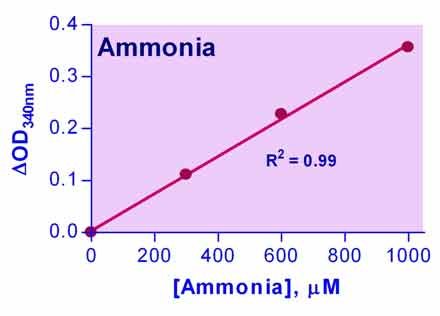EnzyChrom™ Ammonia/Ammonium Assay Kit
Application
- For quantitative determination of ammonia/ammonium and evaluation of drug effects on their metabolism.
Key Features
- High sensitivity and wide linear range. Use a 20 µL sample. Linear detection range from 24 to 1000 µM ammonia.
- Homogeneous and simple procedure. A simple “mix-and-measure” procedure allows reliable quantitation of ammonia within 30 minutes.
Method
- OD340nm, or FL360/450nm
Samples
- Serum, plasma, urine, saliva, cell culture etc
Species
- All
Procedure
- 30 min
Size
- 100 tests
Detection Limit
- 24 µM
Shelf Life
- 6 months
More Details
Ammonia (NH3) or its ion form ammonium (NH4+) is an important source of nitrogen for living systems. It is synthesized through amino acid metabolism and is toxic when present at high concentrations. In the liver, ammonia is converted to urea through the urea cycle. Elevated levels of ammonia in the blood (hyperammonemia) have been found in liver dysfunction (cirrhosis), while hypoammonemia has been associated with defects in the urea cycle enzymes (e.g. ornithine transcarbamylase). Simple, direct, and automation-ready procedures for measuring NH3 are popular in research and drug discovery. BioAssay Systems ammonia assay is designed to directly measure NH3 and NH4+. In this assay, NADH is converted to NAD+ in the presence of NH3, ketoglutarate, and glutamate dehydrogenase. The decrease in optical density at 340 nm or fluorescence intensity at λex/em = 360/450 nm is directly proportionate to the NH3 concentration in the sample.Does glutamate in the sample interfere with the assay?
High glutamate concentrations (> 2 mM) will interfere with the assay. For example, a typical concentration of glutamate in cell culture medium is ~ 0.15 mM.
Hewitt, D. J., et al. (2020). Effects of divergent selection for residual feed intake on nitrogen metabolism and lysine utilization in growing pigs. Journal of Animal Science. 98(5). Assay: Ammonia/Ammonium in pig urine.
Hinow, P., et al. (2021). Modeling the bidirectional glutamine/ammonium conversion between cancer cells and cancer-associated fibroblasts. PeerJ, 9: e10648. Assay: Ammonia/Ammonium in human breast cancer cell line MDA-MB-231.
Ono, M., & Yoshiga, T. (2019). Cellular immunity in the insect Galleria mellonella against insect non-parasitic nematodes. Parasitology, 146(6), 708-715. Assay: Ammonia/Ammonium in Galleria mellonella greater wax moth.
Jiang, S., Yan, W., Wang, S. E., & Baltimore, D. (2018). Let-7 suppresses B cell activation through restricting the availability of necessary nutrients. Cell metabolism, 27(2), 393-403. Assay: Ammonia/Ammonium in mouse B cells.
Sartori, R., Leme, J., Caricati, C. P., Tonso, A., & Nunez, E. G. F. (2018). Model Comparison To Describe BHK-21 Cell Growth And Metabolism In Stirred Tank Bioreactors Operated In Batch Mode. Brazilian Journal Of Chemical Engineering, 35(2), 441-458. Assay: Ammonia/Ammonium in monkey bhk! Cell supernatant.
Zhu, J., Zhu, X. G., Ying, S. H., & Feng, M. G. (2017). Effect of vacuolar ATPase subunit H (VmaH) on cellular pH, asexual cycle, stress tolerance and virulence in Beauveria bassiana. Fungal genetics and biology, 98, 52-60. Assay: Ammonia/Ammonium in B. bassiana fungus.
Wang, L et al (2015). CtBP maintains cancer cell growth and metabolic homeostasis via regulating SIRT4. Cell Death and Disease 6: e1620. Assay: Ammonia/Ammonium in mice tumor tissue.
Nunez EG et al (2014). Influence of aeration-homogenization system in stirred tank bioreactors, dissolved oxygen concentration and pH control mode on BHK-21 cell growth and metabolism. Cytotechnology 66(4): 605-617. Assay: Ammonia in hamster cells.
Yu Z et al (2014). Advances in detection methods of L-amino acid oxidase activity. Appl Biochem Biotechnol. 174(1):13-27. Assay: Ammonia.
Rauner, G et al (2013). Development of Foreign Mammary Epithelial Morphology in the Stroma of Immunodeficient Mice. PloS one 8.6: e68637. Assay: Ammonia in mouse cell culture medium.
To find more recent publications, please click here.
If you or your labs do not have the equipment or scientists necessary to run this assay, BioAssay Systems can perform the service for you.
– Fast turnaround
– Quality data
– Low cost
Please email or call 1-510-782-9988 x 2 to discuss your projects.

$419.00
For bulk quote or custom reagents, please email or call 1-510-782-9988 x 1.
Orders are shipped the same day if placed by 2pm PST
Shipping: On Ice
Carrier: Fedex
Delivery: 1-2 days (US), 3-6 days (Intl)
Storage: -20°C upon receipt
Related Products
You may also like…
| Name | SKU | Price | Buy |
|---|---|---|---|
| EnzyChrom™ Acetate Assay Kit | EOAC-100 | $489.00 | |
| EnzyChrom™ Oxalate Assay Kit | EOXA-100 | $639.00 | |
| QuantiChrom™ Zinc Assay Kit | DIZN-250 | $539.00 | |
| QuantiFluo™ Ammonia Assay Kit | DNH3-200 | $229.00 | |
| QuantiChrom™ Sulfate Assay Kit | DSFT-200 | $419.00 | |
| QuantiChrom™ Phosphate Assay Kit | DIPI-500 | $409.00 | |
| QuantiChrom™ Calcium Assay Kit | DICA-500 | $439.00 | |
| QuantiChrom™ Chloride Assay Kit | DICL-250 | $389.00 | |
| QuantiChrom™ Copper Assay Kit | DICU-250 | $539.00 | |
| QuantiChrom™ Iron Assay Kit | DIFE-250 | $479.00 | |
| QuantiChrom™ Magnesium Assay Kit | DIMG-250 | $469.00 | |
| QuantiChrom™ Chromium Assay Kit | DCRM-250 | $509.00 |
Why BioAssay Systems
Quality and User-friendly • Expert Technical Support • Competitive Prices • Expansive Catalogue • Trusted Globally
